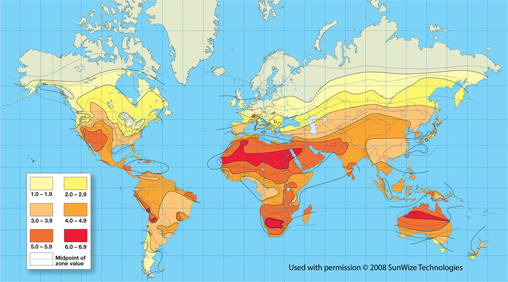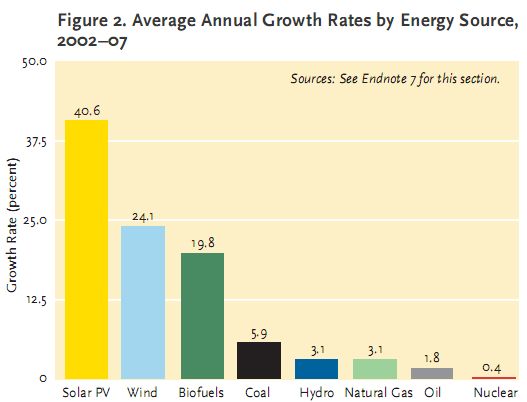So many reports, so little time!
Greenpeace: The True Cost of Coal
It’s well-known that coal’s price is artificially low, since many of its costs — health maladies, climate change, polluted water, etc. — are externalized. But how much do those externalized costs add up to? This report delves into that subject in great detail. In terms of measurable costs, it comes up with $451 billion annually — and that’s not including other costs from, say, groundwater contamination, for which there aren’t reliable global estimates.
As I’m always saying, coal’s "cheapness" is an artifact of poor accounting. It’s an illusion. This report explains why.
There’s a good summary on SolveClimate.
The Center for American Progress: A Framework for Achieving Energy Security and Arresting Global Warming
One thing I like about this one, written by Ken Berlin, is that it’s realistic about both the virtues and the limitations of market-based mechanisms to reduce GHG emissions. It argues that carbon pricing is necessary but not sufficient — you also need a little old-fashioned command-and-control regulation.
But it’s possible to regulate wisely, as Berlin notes in this apt description of performance standards (goals not paths!):
Because performance mandates require a performance level and not the use of a particular technology, they do not force a choice between different technologies and, thus, the selection of winners and losers — the key objection that free market economists have to technology deployment programs. Performance mandates therefore allow full-market competition over a range of options that could ultimately achieve the prescribed performance standard.
Because these performance standards are mandated before they can be produced at the lowest cost, they are likely to be far more expensive in the early years of their deployment than they would be for second- or third-generation plants, vehicles, or products. The government should therefore subsidize early deployment in order to make mandates acceptable to industry and reduce the effect of rapidly rising costs on consumers. These subsidies — particularly if funded from the sale of allowances in a cap-and-trade auction, as described in the next section — should be viewed as a reallocation of funds from more- to less-intensive sources of CO2 emissions and from less- to more-fuel-efficient vehicles. The subsidies would speed the transition to more sustainable, carbon-free sources of energy and far more fuel-efficient vehicles.
Global Green USA: Solar Report Card
The Solar Report Card is a comprehensive assessment of the state of solar power — how much is installed, how well it’s working, and drivers for future growth — in 16 leading nations and the state of California. (Spain is now third in installed capacity, exceeding the U.S. for the first time.) NewEnergyNews has a summary, but with a report this rich you need to dig in. I like this:
Indeed, with today’s solar technology we can access about 4 times the world’s annual demand for power and we can do so cleanly. The solar industry, growing at rates of 40-50%, offers tremendous economic and employment opportunities.
Word.
U.S. Department of Energy’s Industrial Technologies Program: Combined Heat and Power: Effective Energy Solutions for a Sustainable Future [PDF]
This reasonably short report makes a simple point: CHP, or cogeneration, or recycled energy, or whatever you want to call it, is teh awesome. More specifically:
This report describes in detail the four key areas where CHP has proven its effectiveness and holds promise for the future — as an:
* Environmental Solution: Significantly reducing CO2 emissions through greater energy efficiency
* Competitive Business Solution: Increasing efficiency, reducing business costs, and creating green-collar jobs
* Local Energy Solution: Deployable throughout the US
* Infrastructure Modernization Solution: Relieving grid congestion and improving energy security
Right now CHP provides under 10 percent of U.S. energy, but it is woefully underutilized. With smart policy it could easily be ramped up to 20 percent by 2030, the report says, with the benefit of taking the equivalent of 154 million cars — about half the U.S. fleet — off the road.
This is such a gimme, such a no-brainer, it’s a crime it’s not a bigger part of the energy discussion.
Worldwatch: Low-Carbon Energy
This is mostly a good summary of stuff Grist readers are familiar with: Emissions are rising, catastrophe is approaching, we need dramatic action, let’s start with efficiency, ramp up clean energy, here’s the policies we need, etc.
One good part is the careful account of what sources of power are growing, and how fast. It contains this heartening graph:
And I like this discussion of how to deal with intermittency:
As reliance on coal is reduced in the decades ahead, it is likely that many regions will need to move well beyond the 20-percent threshold for wind, solar, and other variable power sources. To do this, they can pursue some combination of four strategies: 1) add local generating capacity using combined heat and power (CHP) systems, including advanced technologies such as microturbines and fuel cells that can be turned on and off as needed; 2) integrate variable sources with digital smart grids that are more flexible in their ability to balance demand and supply; 3) develop the capacity to store energy economically so that it is available when needed — with options such as pumped hydro, compressed air, and advanced chemical batteries and fuel cells; and 4) selectively add a new generation of efficient, low-cost gas turbines to provide spare backup power.
Worldwatch is optimistic: They think the clean energy revolution is already underway and will proceed much faster than conventional wisdom has it.



